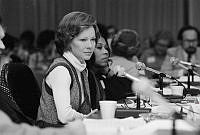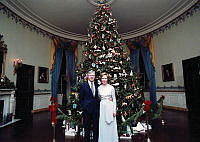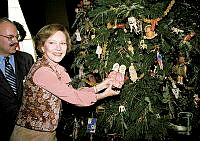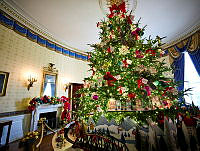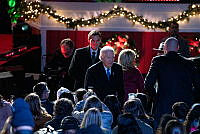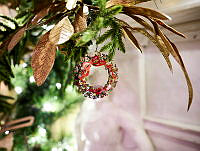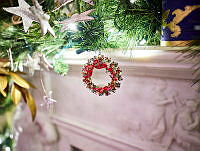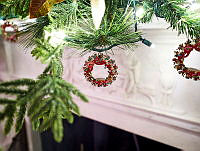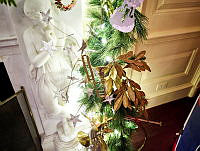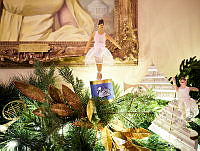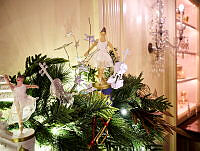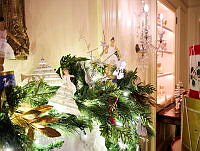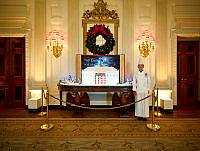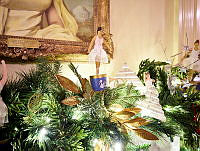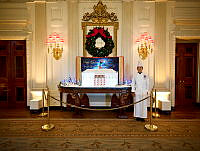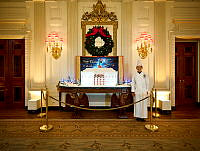Rubenstein Center Scholarship
First Ladies and Cherry Blossoms
A Blooming Legacy
Every spring, the National Cherry Blossom Festival commemorates the 1912 gift of 3,020 cherry trees from Mayor Yukio Ozaki of Tokyo, Japan, to the city of Washington, D.C. This cherished tradition has deep historic ties to the White House and the nation’s first ladies, beginning with First Lady Helen Herron Taft.
For over twenty years, writer Eliza Ruhamah Scidmore, known for her travels in Alaska and the Far East, mounted an unrelenting crusade, encouraging federal officials to plant Japanese cherry trees in Washington, D.C.’s Potomac Park.1 Scidmore found inspiration in the Japanese celebrations of Tokyo’s cherry blossoms, writing, “Even more beautiful than the plum-tree festival is the Tokio [sic] celebration of the blossoming of the cherry, and gayer than the brilliant throngs are the marvellous [sic] trees.”2 Although Scidmore did everything in her power to champion this cause, three presidential administrations came and went before she finally found someone willing to take action.
When Helen Taft became first lady in the spring of 1909, Scidmore reached out once again about her proposal. This time she found a match. The first lady was already committed to boosting Potomac Park’s social atmosphere with the addition of a band stand and regularly scheduled concerts.3 Mrs. Taft was also quite familiar with the beauty of Japanese gardens and flowering cherry trees, having traveled to Japan with Scidmore’s mother in 1900 during her husband’s tenure as civilian governor of the Philippines.4

A 1910 portrait of Helen Herron Taft by Bror Kronstand.
White House Collection/White House Historical AssociationOnce the first lady took up the cause, she requested all flowering cherry trees in American nurseries be set aside for planting in Potomac Park. Following this request, on April 14, 1909, the Superintendent of the Office of Public Buildings and Grounds, Colonel Spencer F. Cosby, purchased ninety cherry trees for planting.5 At the same time, Scidmore, chemist Jokichi Takamine, and Kokichi Mizuno, the Japanese consul general in New York, arranged a gift of 2,000 trees from the mayor and city council of Tokyo.6 Sadly, when this batch of trees arrived in January 1910, agricultural inspectors discovered the trees infected with insects and disease. On January 28, 1910, President William Howard Taft granted his permission to burn the diseased trees.7
This unfortunate incident did not deter Mrs. Taft or Miss Scidmore. They worked with the mayor of Tokyo, Yukio Ozaki, to procure additional trees. In early March 1912, a second gift of 3,020 cherry trees arrived in Seattle, Washington, aboard the freighter Awa Maru. This time the trees were carefully packed to prevent infection. The trees then made their way across the country in heated, insulated railroad cars to Washington, D.C.8 On March 27, 1912, Mrs. Taft and Iwa Chinda, wife of the Japanese ambassador, planted the first two cherry trees along the northern bank of the Tidal Basin in a ceremony attended by Eliza Scidmore. Today, those trees still stand just east of the Martin Luther King, Jr. Memorial.9

First Lady Claudia "Lady Bird" Johnson and Madame Takeuchi, wife of the Japanese ambassador, reenact the original 1912 tree planting on April 4, 1965.
Lyndon B. Johnson Presidential Library and Museum/NARAAs the years passed the annual blooming of the cherry trees in Potomac Park delighted city residents. First ladies certainly enjoyed the beauty of the trees, and some brought blossoms into the White House. First Lady Ellen Axson Wilson incorporated cherry blossoms into her daughter’s wedding on May 7, 1914. The intimate ceremony took place in the Blue Room, decorated with cherry blossoms, apple blossoms, lilies, and dogwood flowers.10
Several years later, First Lady Florence Harding directed gardeners to plant cherry trees on the White House Grounds and proceeded to cut fresh blossoms for decoration the following spring.11
In 1934, the District of Columbia Commissioners hosted the first annual Cherry Blossom Festival. First Lady Eleanor Roosevelt took an active role in the celebration by opening the three-day festival. On April 19, 1934, the first lady led a 6:00 a.m. sunrise ceremony alongside a delegation from the Japanese Embassy and Miss Eleanor Roosevelt, the Queen of the Cherry Blossoms and daughter of Assistant Secretary of the Navy, Henry L. Roosevelt. The ceremony, featuring a special concert by the Marine Band and a program of dances, was held between the two famous cherry trees planted by Mrs. Taft in 1912.12 The festival also featured an air show, parade, and fireworks display at the Washington Monument. On the final night of the festival, the first lady attended the Cherry Blossom Ball at the Mayflower Hotel to watch as the Queen of the Cherry Blossoms danced with her court.13

President Richard Nixon and First Lady Patricia Nixon admiring the cherry blossoms during a walk along the Tidal Basin on April 14, 1969.
Richard Nixon Presidential Library and Museum/NARAPresident Franklin Roosevelt also unwittingly became involved with the famous trees when he found himself embroiled in a cherry tree scandal. In 1937, the Thomas Jefferson Memorial Commission selected the Tidal Basin as the location for the Jefferson Memorial, leading to widespread public criticism over removing cherry trees for the memorial’s construction. “The Cherry Tree Rebellion” soon followed as The Washington Times-Herald published several articles criticizing the Roosevelt administration. Groups throughout the city rallied to protest the removal of cherry trees. On November 17, 1938, forty women marched on the White House to deliver a letter to President Roosevelt asking him to save the trees. The following day, a group of 150 women descended upon the construction site, shackling themselves to trees. President Roosevelt addressed the protest in a press conference the same day, refusing to interfere in the memorial plans and hitting back at The Washington Herald-Times for inflating the situation, stating, “It is the worst case of flim-flamming that this dear old capital of ours has been subjected to for a long time.”14
Despite the protests, the trees were transplanted and the Jefferson Memorial was dedicated on April 13, 1943. The following day, First Lady Eleanor Roosevelt addressed the cherry tree controversy in her My Day column: “Yesterday we attended the dedication of the Jefferson Memorial. It is beginning to look very beautiful and someday, when the cherry trees around it bloom in great profusion, people will forget that we were ever afraid of spoiling the landscape around the Basin.”15

First Daughter Tricia Nixon poses with the 1970 Cherry Blossom Princesses on the steps of the South Portico of the White House.
Richard Nixon Presidential Library and Museum/NARAAfter the memorial’s completion all was quiet on the cherry tree front as the annual festival continued and the admiration for the trees flourished. Elizabeth “Bess” Truman enjoyed a newly planted cherry tree on the White House Grounds, while Mamie Eisenhower participated in the 1953 Cherry Blossom Festival pageant. The Cherry Blossom Pageant was first introduced to the festival in 1940, and beginning in 1948 each state and federal territory began selecting a cherry blossom princess for the competition. During the 1953 festival, Mrs. Eisenhower arrived to the Tidal Basin to crown eighteen-year-old Ohio resident, Janet Bailey, Cherry Blossom Festival Queen.16
First Lady Claudia “Lady Bird” Johnson was particularly fond of the cherry blossoms. Lynda Johnson Robb recalled that her mother, “absolutely loved the cherry blossoms.”17 As the creator of the First Lady’s Committee for a More Beautiful Capital, securing more cherry trees for the National Mall coincided with the first lady’s goals. Mrs. Johnson reenacted the 1912 tree planting at the opening ceremony of the 1965 National Cherry Blossom Festival. She planted a cherry tree alongside Mrs. Ryuji Takeuchi, the wife of the Japanese ambassador. During the ceremony, Ambassador Takeuchi announced that Japanese Prime Minister Eisako Sato would provide a gift of 3,800 trees. Mrs. Johnson expressed her appreciation for the generous gift, “This is such a happy moment. We have only to look around us to see evidence of the generosity of Japan.”18

First Lady Betty Ford greets the Cherry Blossom Princesses on April 7, 1976. The princesses had gathered to wish the first lady an early happy birthday.
Gerald R. Ford Presidential Library and Museum/NARAFirst Lady Patricia Nixon also delighted in the spring cherry blossoms. During the 1970 National Cherry Blossom Festival parade Mrs. Nixon found herself caught in a traffic jam. She later stated, “I had my own parade and loved it... The Cherry Blossom Queen princesses waved and blew kisses. It was a treat.”19
She began inviting the princesses to the White House for receptions. This tradition continued under several other first ladies including Betty Ford. On one memorable occasion in April 1976, forty-eight princesses gathered in the Rose Garden to serenade Mrs. Ford for her 58th birthday with a rendition of “Happy Birthday”20
Rosalynn Carter and Nancy Reagan also invited the princesses to the White House.

President Jimmy Carter greets the Cherry Blossom Princesses on April 5, 1979, in the Rose Garden.
Jimmy Carter Presidential Library and Museum/NARAIn February 1981, First Lady Nancy Reagan presented a three-foot cherry tree to Japanese Ambassador Yoshio Okawara. This tree was propagated at the National Arboretum from one of the original 1912 cherry trees. Mrs. Reagan expressed her appreciation of the cherry trees, “By sharing these plants and their beauty with the people of the United States in the early 1900’s, the Japanese people have helped establish the cherry blossom tradition which has become an annual spring rite for thousands of visitors to the nation’s capital.”21 Mrs. Reagan also began serving as honorary chairperson of the National Cherry Blossom Festival.22

First Lady Michelle Obama participates in a centennial tree planting ceremony during the National Cherry Blossom Festival on March 27, 2012.
Official White House Photo by Lawrence JacksonThis tradition has been kept alive by the most recent first ladies as well. First Lady Hillary Clinton took part in ceremonial tree plantings in 1997 and 1999, while First Lady Laura Bush held a spectacular opening event at the John F. Kennedy Center for the 2001 festival. On March 27, 2012, 100 years to the day, First Lady Michelle Obama took part in a reenactment of Helen Taft’s 1912 planting. Mrs. Obama was joined by William H. Taft IV, the great-grandson of President and Mrs. Taft, to plant a new sapling along the Tidal Basin. The first lady spoke about the resilience of cherry trees and hoped, “the First Lady—or the First Gentleman—of 2112 will also have the privilege of joining with our friends from Japan, and planting another tree which will bloom for yet another one hundred years and beyond.”23




















